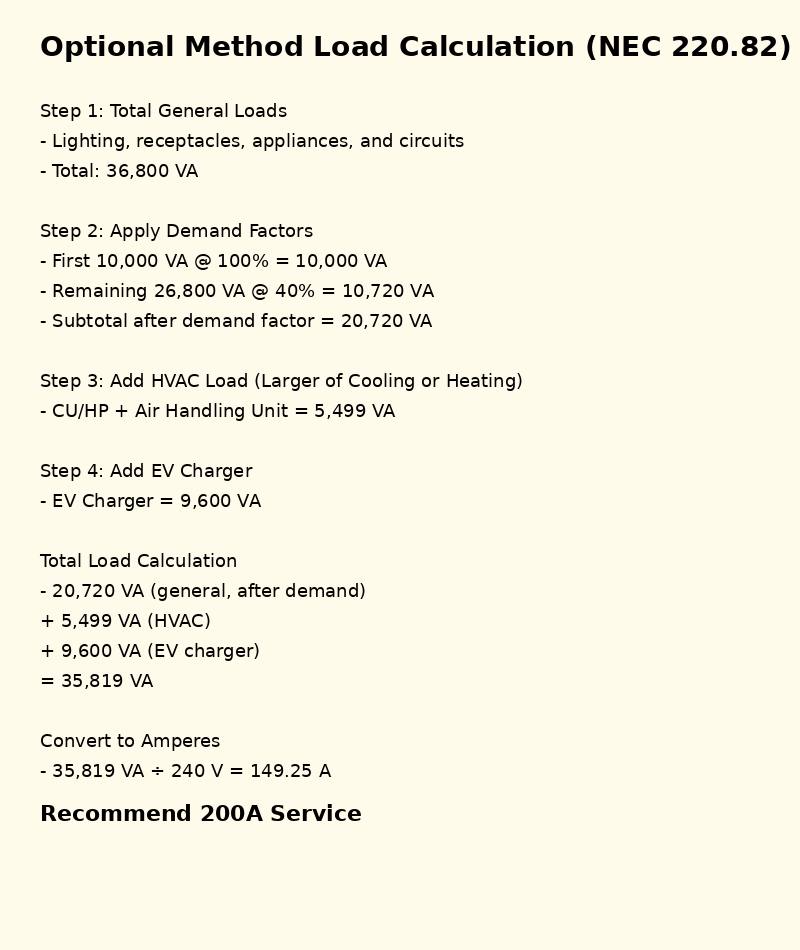
Accurate service sizing is critical in residential electrical design—not only for code compliance but also for safety, cost-efficiency, and long-term reliability. The National Electrical Code (NEC) provides two recognized approaches for dwelling unit load calculations: the standard method and the optional method. While the standard method offers detailed precision, the optional method, found in NEC 220.82, is a time-saving alternative tailored for single-family and certain multi-family applications.
This article walks you through the optional method with a new example using original values and compliant calculation steps.
When Can You Use the Optional Method?
Per NEC 220.82, the optional method may be used if:
-
The dwelling is single-family, two-family, or part of a multi-family structure with individual feeders or services.
-
The service rating is 100 amps or more.
It is particularly useful for dwelling units with electric cooking, HVAC, and multiple appliances, helping to avoid oversized services by applying diversity factors.
Step-by-Step Load Calculation Example
Let’s walk through a load calculation using the Optional Method for a 2,500 sq. ft. single-family home:
– Lighting & Receptacle Load
-
3 VA × 2,500 sq. ft. = 7,500 VA
– Small Appliance & Laundry Circuits
-
2 small appliance circuits @ 1,500 VA = 3,000 VA
-
1 laundry circuit @ 1,500 VA = 1,500 VA
Total = 4,500 VA
– Appliance Loads (nameplate)
-
Range = 12,000 VA
-
Dryer = 5,000 VA
-
Dishwasher = 1,200 VA
-
Disposal = 800 VA
-
Microwave = 1,000 VA
-
Water heater = 4,500 VA
Total = 24,500 VA
– HVAC
-
Central AC = 4,000 VA
-
Electric heat = 10,000 VA
Use the larger: 10,000 VA
Apply Demand Factors (Per NEC 220.82(B))
Total before HVAC:
-
7,500 + 4,500 + 24,500 = 36,500 VA
Apply demand factor:
-
First 10,000 VA @ 100% = 10,000 VA
-
Remaining 26,500 VA @ 40% = 10,600 VA
Subtotal = 20,600 VA
Add HVAC (no demand factor):
-
Electric heating = 10,000 VA
Total Calculated Load = 30,600 VA
Convert to Amperes
-
30,600 VA ÷ 240 V = 127.5 Amps
Recommended service size: 200A
Why Use the Optional Method?
-
Saves time by simplifying complex calculations
-
Results in smaller service sizes without compromising safety
-
Ideal for all-electric homes
-
Fully compliant with NEC standards when applied correctly
Conclusion
The Optional Method under NEC 220.82 is a valuable tool for electrical professionals working on residential projects. When used correctly it leads to more efficient and cost-effective service sizing.
Refer to the link below to begin the Optional Method load calculation for single dwelling unit:

